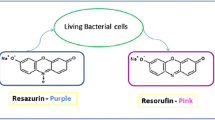Abstract
Purpose
The traditional methods described in pharmacopeias most commonly used by the pharmaceutical industry are easy to perform and the costs are affordable, but they require long periods of time to obtain the results and often do not present sensitivity for recovering microorganisms in vulnerable physiological states known as viable but nonculturable. Thus, the objectives of this study were to evaluate the potential applicability of flow cytometry in non-sterile pharmaceutical products.
Methods
This paper implemented the analytical validation steps, through the reference strains and productive environment bioburden, by analyzing the traditional method in parallel to the alternative method with flow cytometry.
Results
The results indicated, with a 95% probability of detection, that there were no significant differences between the methods in relation to the ability to detect microbial contamination; however, the detection was faster with the flow cytometry method than the traditional method, which indicates that this technology is a viable alternative to be implemented.
Conclusions
The study demonstrated that the alternative microbiological method presents greater sensitivity in the analyses carried out, guaranteeing greater patient safety, besides allowing results to be obtained in a short period of time, thus enabling anticipation of investigations on possible failures that may occur during the process. Additionally, the study contributes to the environment by reducing waste generation and saving energy.





Similar content being viewed by others
References
FARMACOPEIA BRASILEIRA, 5ª edição. Métodos Microbiológicos Alternativos. Primeiro Suplemento. Brasília, 36–39, 2016
Breeuwer p, Abee t. Assessment of viability of microorganisms employing fluorescence techniques. Int J Food Microbiol. 2000;55(1–3, 193):–200.
Bugno A, et al. Application of the BacT/ALERTR 3D system for sterility testing of injectable products. Braz J Microbiol São Paulo. 2015;46(3):743–7.
Bugno, Adriana, Almodóvar, Adriana Aparecida Buzzo, & Pereira, Tatiana Caldas. Enumeration of heterotrophic bacteria in water for dialysis: comparison of the efficiency of Reasoner'2 agar and plate count agar. Braz J Microbiol. 2010;41(1):15–18. https://doi.org/10.1590/S1517-83822010000100003.
Díaz M, et al. Application of flow cytometry to industrial microbial bioprocesses. Biochem Eng J. 2010;48:385–407.
European Pharmacopoeia. 9.0 ed. 5.1.6 – Alternative methods for control of microbiological quality. Strasbourg: European Directorate for the Quality Medicines; 2017.
Japanese Pharmacopoeia 17th ed. [internet]. Tokyo: Ministry of Health, Labour and Welfare; 2016. Available from: https://www.pmda.go.jp/english/rs-sb-std/standards-development/jp/0019.html [cited 2019 Mai 09];
Li L, et al. The importance of the viable but non-culturable state in human bacterial pathogens. Front Microbiol. 2014;5(JUN):1–1.
Miller M. The implementation of rapid microbiological methods. Eur Pharm Rev. 2010:24–6.
Parenteral Drug Association. PDA Technical Report No. 33 (Revised 2013). Bethesda: Evaluation, validation and implementation of alternative and rapid microbiological methods; 2013.
Pinto T d JA, Kaneco TM, Pinto AF. Controle Biológico de Qualidade de Produtos Farmacêutico, Correlatos e Cosméticos. Quartaedição. São Paulo: Manole; 2015. p. 129–35.
Ratajczak M. Microbiological quality of non-sterile pharmaceutical products. Saudi Pharm J. July 2015;23:303–7.
Sage, A. et al. European Journal of Parenteral & Pharmaceutical Sciences for automated rapid microbiology EM methods determining incubation regime and time to results for automated rapid microbiology EM methods. 19(2), p. 45–55, 2014;
Sandle, Tim. Introduction to pharmaceutical microbiology. In: Pharmaceutical microbiology: essentials for quality assurance and quality. Wood head Publishing, 2016. https://www.elsevier.com/books/pharmaceutical-microbiology/sandle. Accessed 02 Apr 2019.
Santos A, Doria M, Soares L, Almeida A, Menezes J. A QRM discussion of microbial contamination of non-sterile drug products, using FDA and EMA warning letters recorded between 2008 and 2016. PDA J Pharm Sci Technol. 2018;72(1):62–72. https://doi.org/10.5731/pdajpst.2016.007252.
UNITED STATES PHARMACOPEIA, USP 40. Validation of alternative microbiological methods. The National Formulary, NF 35. Rockville: The United States Pharmacopeial Convention; 2017.
Wilkinson MG. Flow cytometry as a potential method of measuring bacterial viability in probiotic products: a review. Trends Food Sci Technol. 2018;78(May):1–10.
Acknowledgments
The authors are grateful to the leaders of the Pharmaceutical Industry for providing the flow cytometry technology, the experimental batches of the product, the consumables, and all the support necessary for performing this study.
Author information
Authors and Affiliations
Corresponding author
Ethics declarations
Conflict of interest
The authors declare that they have no conflict of interest.
Ethical Approval
This article does not contain any studies with human participants or animals performed by any of the authors.
Additional information
Publisher’s Note
Springer Nature remains neutral with regard to jurisdictional claims in published maps and institutional affiliations.
Rights and permissions
About this article
Cite this article
Lemos, M.A., Ghisleni, D.D.M. & de Jesus Andreoli Pinto, T. Validation of Alternative Microbiological Method in Non-sterile Pharmaceutical Product Through the Reference Strains and Productive Environment Bioburden. J Pharm Innov 15, 641–650 (2020). https://doi.org/10.1007/s12247-019-09408-1
Published:
Issue Date:
DOI: https://doi.org/10.1007/s12247-019-09408-1




